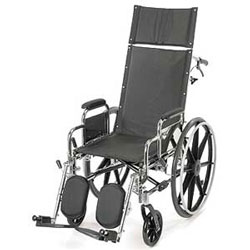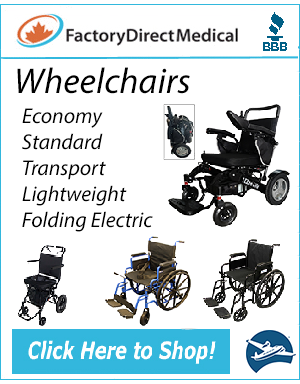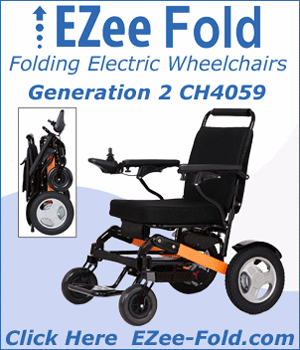
Sunrise Breezy EC Recliner Wheelchair
Reclining Wheelchairs
Recliner wheelchairs are not popular and while some users can benefit from a reclining wheelchair they are rare. There are inherent difficulties with reclining wheelchairs which have to be kept in mind when purchasing and determining options and seating. They are heavy wheelchairs, not very transportable difficult to propel for the user.
The biggest problem with reclining wheelchairs is that when the back is moved from upright to a recline position physics and gravity try to push the users bottom forward on the seat, which causes a shearing action that can, at best be uncomfortable and at worse cause skin breakdown and pressure sores. Unfortunately, when the care giver tries to move the reclined back to the upright position again the shearing pressure isn't reduced and can possibly get worse because the act of moving the back upright often tries to push the user out of the seat even further unless the user is repositioned or the back of the chair is slippery enough for their torso to slide on it as they are being raised.
One way to reduce the effect of this shearing pressure on the buttocks is to equip the wheelchair with elevating legrests. Having the legs elevated, when the footplates are set properly, will transfer some of the forces through the legs to the footplates and may reduce some of the shearing effect.
Because the back of the wheelchair slides against the user's back when reclining and returning to an upright position, the use of any type of contoured or lateral support brackets are prevented on a reclining wheelchair.
In spite of the issues surrounding reclining wheelchairs there are cases when they are necessary and appropriate. The first is when the hips of the user cannot be placed in a 90° position and the user is naturally reclined and another is when one or both knees cannot be bent. Sitting at 90° with one or both legs fully elevated is very uncomfortable for many people and a degree of recline will help.
The basic configuration of the recliner is that of a standard wheelchair with an added feature of the recline.
Seat Widths and Depths
Seat widths for "adult" versions of reclining wheelchairs will range from about 14" to about 22" depending on the model chosen.
Seat depths for "adult" versions of reclining wheelchairs will range from about 16" to about 18" depending on the model chosen.
Seat Height
Seat heights on a reclining wheelchair normally range between 17" and 20".
Back Height
Where a back height on most conventional wheelchairs will be adjustable within a range of 16" to 20" the back height on a recliner must be higher to support the upper back when in a reclined position. The standard back height will be 22" or 23" with a head extension of an additional 10" to support the user's head.
Frames, Weight & Capacities
Reclining wheelchairs are generally designed for institutional use and are of fairly heavy construction. The frames will normally be made of steel and have a weight of between 45 lbs. and 55lbs. They do usually fold from side to side but their weight and overall size makes them difficult to lift and transport.
Casters, Wheels and Tires
The rear wheels on this category of wheelchair are normally available in 20", 22", or 24" with the larger sizes being most common and have either air filled or solid tires but solid are most common.
The front casters on recliner wheelchairs are almost always 8" with solid tires.
Axle Plates
Axle plates are not an option on the recliners however some models have dual wheel mount positions to give some seat height adjustability.
Brakes
Recliner brakes can be the standard push to lock or pull to lock versions standard on most wheelchairs but some models offer attendant operated brakes which are not accessible by the user. This is a handy feature where some degree of dementia is evident and there is a danger the user may not be safe if they release the brakes themselves.
Another option for this category of wheelchair is hill holders, also known as grade aids, which push against the wheels of the wheelchair and prevent them from rolling backward while allowing them to roll forward when climbing slopes Hill holders do not work well with solid tires and are not available unless the chair is configured with air tires or air tires with solid inserts.
Armrests
Armrests can be full length or desk length, adjustable height or fixed height but normally removable.
The full length arms are often an aid to people who use the arms for support when transferring while the desk length allow the chair to positioned close to a table without having to remove or flip them out of the way.
Another consideration is the arm height. The standard arms will be 9" or 10" above the seat rails but once a cushion is added the effective height will be 7" to 8" and too short for most people. If the arms are too short the shoulders will slump and the user will slouch making sitting in the chair uncomfortable fairly quickly so manufacturers came up with height adjustable arms which are the best choice for most people who require armrests.
Footrests
Footrests are pretty basic for reclining wheelchairs. Standard swingaway footrests are available but elevating legrests are the only front rigging which will comfortable for a person using a reclining wheelchair.
Pros
- Will recline
- More comfortable
- Facilitates catheter maintenance
Cons
- Expensive ($3,000.00 - $5,500.00)
- Heavy
- Hard to propel
- Difficult to fold



 Online Vendors
Online Vendors  US Online Vendors
US Online Vendors 

